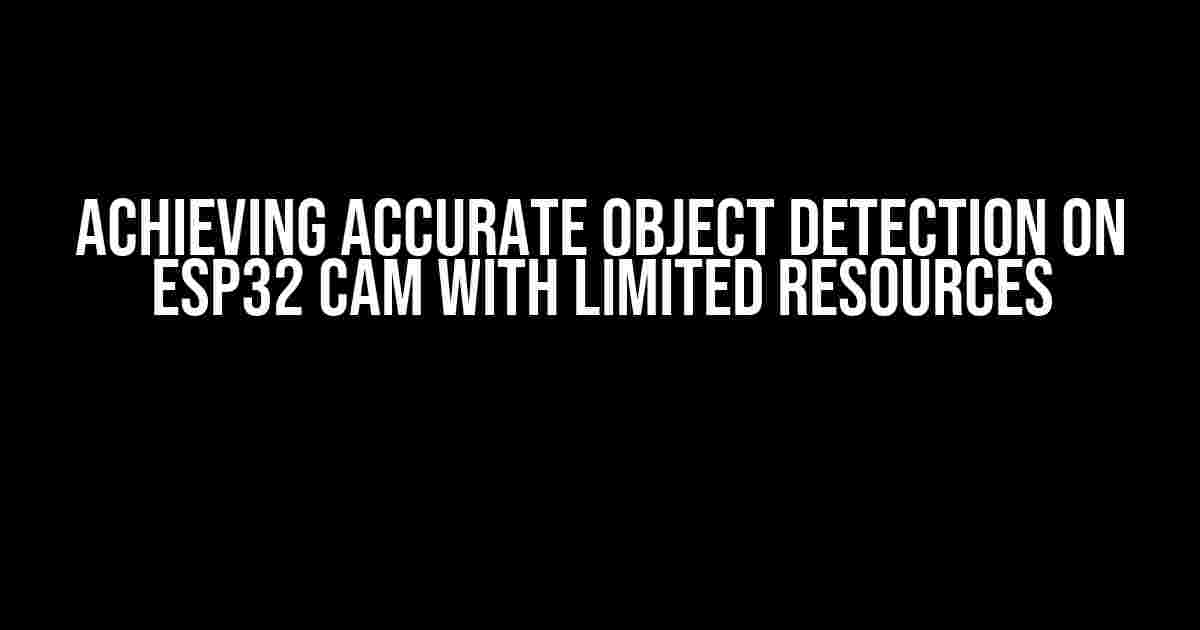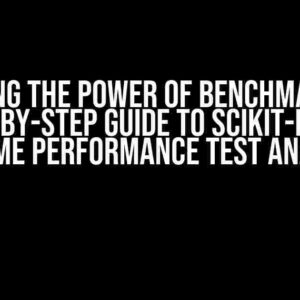Are you ready to take your ESP32 Cam projects to the next level by incorporating object detection capabilities? With limited resources, achieving accurate object detection may seem like a daunting task. Fear not, dear developer, for we’re about to embark on a journey to conquer this challenge!
Understanding Object Detection Basics
Before we dive into the nitty-gritty, let’s cover the fundamentals of object detection. Object detection is a subset of computer vision that involves identifying and locating objects within an image or video stream. There are two primary object detection approaches:
- Classification-based object detection: This approach involves training a classifier to detect objects within an image. Once an object is detected, its location is inferred based on the bounding box surrounding it.
- Regression-based object detection: This method directly predicts the bounding box coordinates and class labels for each object in the image.
In this article, we’ll focus on classification-based object detection using the ESP32 Cam and limited resources.
Challenges of Object Detection on ESP32 Cam
The ESP32 Cam is an incredible piece of hardware, but it’s not without its limitations. When it comes to object detection, we face a few significant challenges:
- Limited processing power: The ESP32 Cam’s processor is not as powerful as those found in computers or high-end smartphones, making it essential to optimize our object detection algorithm for performance.
- Memory constraints: The ESP32 Cam has limited memory, which means we need to be mindful of the model size and complexity to avoid memory overflow issues.
- Power consumption: Object detection can be computationally intensive, which can lead to increased power consumption and reduced battery life.
Don’t worry; we’ll tackle each of these challenges head-on to achieve accurate object detection on the ESP32 Cam.
Preparing the ESP32 Cam for Object Detection
Before we start building our object detection model, let’s ensure our ESP32 Cam is ready for the task. Follow these steps:
- import camera; camera.init(0)
- import camera; camera.capture(‘image.jpg’)
Training the Object Detection Model
We’ll use the popular TensorFlow Lite framework to train our object detection model. TensorFlow Lite provides optimized models for resource-constrained devices like the ESP32 Cam.
For this example, we’ll use the COCO (Common Objects in Context) dataset, which contains 80 object categories. We’ll train a MobileNetV2 model with the COCO dataset using the following steps:
import tensorflow as tf from tensorflow import keras from sklearn.model_selection import train_test_split # Load the COCO dataset train_dir = 'path/to/train/directory' test_dir = 'path/to/test/directory' train_dataset = tf.data.Dataset.list_files(train_dir + '/*.jpg') test_dataset = tf.data.Dataset.list_files(test_dir + '/*.jpg') # Prepare the data for training train_data = tf.data.Dataset.map(train_dataset, lambda x: (tf.image.resize(x, (224, 224)), x)) test_data = tf.data.Dataset.map(test_dataset, lambda x: (tf.image.resize(x, (224, 224)), x)) # Split the data into training and validation sets train_data, val_data = train_test_split(train_data, test_size=0.2, random_state=42) # Create the MobileNetV2 model model = tf.keras.applications.MobileNetV2(weights='imagenet', include_top=False, input_shape=(224, 224, 3)) # Compile the model model.compile(optimizer='adam', loss='categorical_crossentropy', metrics=['accuracy']) # Train the model history = model.fit(train_data, epochs=10, validation_data=val_data)
Once the model is trained, we’ll convert it to a TensorFlow Lite model using the following command:
import tensorflow as tf
# Convert the model to TensorFlow Lite
converter = tf.lite.TFLiteConverter.from_keras_model(model)
tflite_model = converter.convert()
# Save the TensorFlow Lite model to a file
with open('model.tflite', 'wb') as f:
f.write(tflite_model)
Running the Object Detection Model on ESP32 Cam
Now that we have our trained object detection model, let’s run it on the ESP32 Cam. We’ll use the MicroPython TensorFlow Lite library to load and run the model.
import tensorflow as tf
import uos
import camera
# Load the TensorFlow Lite model
model_path = 'model.tflite'
model = tf.lite.Interpreter(model_path)
# Allocate tensors and set input tensor
input_details = model.get_input_details()
output_details = model.get_output_details()
# Initialize the camera interface
camera.init(0)
# Capture an image
img = camera.capture()
# Preprocess the image
img = tf.image.resize(img, (224, 224))
img = img / 255.0
# Set the input tensor
input_tensor = img.reshape(1, 224, 224, 3)
model.set_tensor(input_details[0]['index'], input_tensor)
# Run the model
model.invoke()
# Get the output tensor
output_data = model.get_tensor(output_details[0]['index'])
# Postprocess the output
output = tf.argmax(output_data, axis=1)
# Print the detected object
print('Detected object:', output)
In this example, we load the TensorFlow Lite model, capture an image using the ESP32 Cam, preprocess the image, and run the model. We then postprocess the output to get the detected object.
Optimizing the Object Detection Model for ESP32 Cam
To achieve accurate object detection on the ESP32 Cam with limited resources, we need to optimize our model for performance and memory usage. Here are some tips:
- Quantize the model: Use TensorFlow Lite’s quantization feature to reduce the precision of the model’s weights and activations, which can lead to significant memory savings and improved performance.
- Use a smaller model architecture: Consider using a smaller model architecture, such as MobileNetV1 or ShuffleNet, which can provide better performance and lower memory usage compared to larger models like MobileNetV2.
- Reduce the input image size: Decrease the input image size to reduce the computational requirements and memory usage. However, this may affect the accuracy of the model.
- Optimize the model for inference: Use TensorFlow Lite’s optimization tools to optimize the model for inference, which can improve performance and reduce memory usage.
Conclusion
Achieving accurate object detection on the ESP32 Cam with limited resources requires careful consideration of the challenges and limitations involved. By understanding the basics of object detection, preparing the ESP32 Cam, training and optimizing our model, and running it on the ESP32 Cam, we can achieve impressive results. Remember to optimize your model for performance and memory usage to ensure smooth and efficient object detection.
| Challenges | Solutions |
|---|---|
| Limited processing power | Optimize the model for performance, use a smaller model architecture |
| Memory constraints | Quantize the model, reduce the input image size, optimize the model for memory usage |
| Power consumption | Optimize the model for performance, reduce the input image size, use power-saving techniques |
With these strategies and techniques, you’re well on your way to achieving accurate object detection on the ESP32 Cam with limited resources. Happy coding!
Here are the 5 questions and answers about “Achieving Accurate Object Detection on ESP32 Cam with Limited Resources”:
Frequently Asked Question
Get answers to your most pressing questions about achieving accurate object detection on ESP32 Cam with limited resources.
What are the key challenges in achieving accurate object detection on ESP32 Cam with limited resources?
One of the primary challenges is the limited processing power and memory of the ESP32 Cam, which makes it difficult to run complex object detection algorithms. Additionally, the camera’s resolution and image quality can also impact the accuracy of object detection. Furthermore, the limited storage capacity of the ESP32 Cam can make it challenging to store and process large amounts of data required for object detection.
How can I optimize my object detection model to run efficiently on ESP32 Cam with limited resources?
To optimize your object detection model, you can consider using model pruning, quantization, and knowledge distillation to reduce the model’s size and complexity. You can also use techniques such as image compression and downsampling to reduce the input data size. Additionally, using a lightweight object detection architecture such as YOLO or SSD can also help to improve performance on resource-constrained devices like ESP32 Cam.
What are some strategies for improving object detection accuracy on ESP32 Cam?
To improve object detection accuracy, you can consider using data augmentation techniques to increase the diversity of your training dataset. You can also use transfer learning to leverage pre-trained models and fine-tune them on your specific object detection task. Additionally, using techniques such as object tracking and frame-to-frame inference can help to improve accuracy and reduce false positives.
Can I use transfer learning to adapt pre-trained object detection models to ESP32 Cam?
Yes, transfer learning is a powerful technique that can be used to adapt pre-trained object detection models to ESP32 Cam. By fine-tuning a pre-trained model on your specific object detection task, you can leverage the knowledge learned from the pre-trained model and adapt it to your specific use case. This can reduce the amount of training data and computational resources required to achieve accurate object detection.
What are some best practices for deploying object detection models on ESP32 Cam in real-world applications?
When deploying object detection models on ESP32 Cam, it’s essential to consider factors such as power consumption, latency, and robustness to varying environmental conditions. You should also ensure that your model is optimized for the specific camera settings and image quality of the ESP32 Cam. Additionally, implementing proper error handling and fault tolerance mechanisms can help to ensure reliable and accurate object detection in real-world applications.


